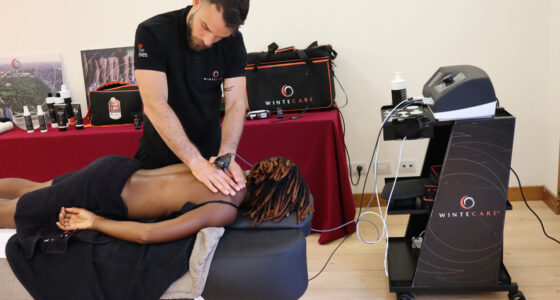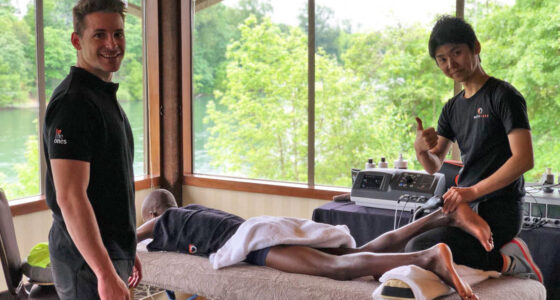Tecar-Cret
The word tecar identifies a specific type of technology used in different areas of physiotherapy.
It has spread widely through several European countries over the last 20 years and has been a supporting tool for thousands of therapists dealing with inflammatory problems, pain and biomechanical issues that affect their patients.
Online you will find many articles and contents that describe tecar, but as it often happens for topics of recent scientific study, the feedback you receive may vary depending on the source that is consulted, making life difficult for those who want to receive guidance.
The most common application fields where we can “incur” in a prescription for a certain number of “Tecar” or “Tecar Therapy” sessions are manifold: tendinopathies and tendinosis, post-surgical rehabilitation, muscle strain and sprain, joint sprains, bruises, acute and chronic pain, lymphedema. The reason for this array of prescriptions is that this type of technology stimulates reactions useful to support various physiological and endogenous processes in the human body. Although when using the word tecar or synonyms (e.g. CRET) as a search key recent studies found on search engines such as Pubmed confirm the effectiveness of the tool for many of the areas for which it is normally prescribed, the public opinion is still divided on its effectiveness.
There are a number of reasons that explain the current state of affairs.
To simplify things we will just report those that seem most relevant to us:
- First reason is that the studies published in scientific journals are relatively recent and therefore still need some time before they can be assimilated by the clinical community.
- Second rason, far more complex, is linked to the fact that the effectiveness of a series of treatments also depends on variables which are independent from the instrument itself. The most important one is related to the operator’s knowledge and ability to link instrument stimulated reactions to the clinical objective.
To use a metaphor, knowing a car can be a suitable tool to take us from one city to another is not enough to make sure we get there.
To reach our goal we need to know the road, how to maneuver the car and be able to respect traffic rules so as not to run into problems during the journey.
Only by governing all these aspects we will achieve our objective.
For an instrumental physical therapy device things are not very different. Even if medicine requires us to define rigid protocols when facing a pathology, these protocols must be based above all on the knowledge of the variables involved and on the ability of those who apply the tools to adapt the protocol to the specific case. Someone wiser than us in unsuspicious times already claimed that “it is more important to know the type of person who has the disease rather than knowing the type of disease…” (Hippocrates).
Understanding how to adapt the use of “tecar” to each patient in front of us is a fundamental element for therapeutic success.
In our way we will try to make the effort to introduce you to tecar technology basing on the most objective elements possible, inviting you to go deeper into the topic also through the consultation of scientific studies currently published in impact factor journals and easily available through the Pubmed portal.
Tecar is in fact an acronym that summarizes the concept of “resistive capacitive energy transfer”. Starting from this assumption, we can begin to understand what the purpose of this technology is, what types of energy it uses and the reactions it can stimulate in your body.

We can first of all say that “the tecar” is a tool used to transfer energy to the body. In physics there are different types of energy such as mechanical, thermal, atomic, chemical, etc. In the case of tecar technology the energy involved is electromagnetic, i.e. an electric, or better electromagnetic field, is used to transfer energy to the body tissues.
This concept is also highlighted by the words “capacitive” and “resistive” contained in the definition of tecar, which describe two ways of transferring or generating a current in a given physical medium. The concepts of capacitive and resistive in fact, do not originate with “the tecar” or with tecartherapy, but reside in the description of how a current behaves within an electrical circuit. Without going into an applied electronics dissertation, we can say with good confidence that a resistive current is transferred to a conductor, while a capacitive current is “generated” inside a conductor. It sounds like a subtlety, but from an energetic point of view it makes a big difference depending on where the effects of the therapy are concentrated.
The question we should ask ourselves now is: what is the point of transferring energy to the human body?
The complete answer would probably require a quantity of content, sources and time resembling a Master’s degree in instrumental physical therapy. We need to think that each therapeutic action implies a change in the energy status of the tissue: in manual therapy we actually use mechanical energy to trigger reactions, ranging from simple kinesis (movement) to a change in the viscoelasticity of the interested area; with a drug, chemical energy is used to trigger, inhibit or control some physiological processes related to the chemical and electrical gradient in the tissues. For example, when we place a hot water bottle on our abdomen because we have a common “stomach ache”, we are actually using thermal energy to trigger a nociceptive reaction, that is, on the perception of pain.
In this perspective we can consider energy as a means of making something happen. The type of energy, the amount, density and the method with which it is applied are important discriminants for the therapeutic outcome.

In tecar we are able to transfer energy to the body by applying an electromagnetic field through contact. Some tecar instruments are able to control the amount of energy transferred each second very precisely allowing you to decide whether to transfer small or large quantities of energy. Another interesting element is that some types of “tecar” allow you to decide whether to transfer this energy to well-identified portions of tissue or to larger areas. Another element to consider is how energy tends to be distributed within the tissue.
How do I know if my therapy is supporting the healing process of the internal tissue of a tendon?
First of all, I need to know if the energy transferred through a certain therapeutic action is able to reach the portion of tissue to be treated. Since the human body is far from being a perfect conductor and is highly complex also from an electrical point of view, relying on theoretical models is not enough to predict the behavior of a certain type of electromagnetic field within the body, you must explore further with experimental tests.
This is why we consider of great significance the studies conducted by the International University of Catalonia (UIC) in collaboration with the Unidad de investigación de physiotherapy of Zaragoza to measure the depth of the current and the behaviour of the temperature inside the tissues when the tecar T-Plus instrument is applied to the body.

It is almost surprising to see how deep we can go right from the first second of application! For those wishing to investigate further, we strongly suggest you to consult one of the articles dealing with this topic recently published in the impact factor magazine on Pubmed.
Thanks to this kind of analysis we are able to describe the effects of our instruments in an even more precise way and help doctors and therapists to control the effects of the therapies carried out using our instruments. In a nutshell, the tecar, from a clinical point of view, is nothing more than a generator of endogenous reactions at circulatory level that therapists use to quickly influence inflammatory, nociceptive, reparative and biomechanical processes. Whether or not these reactions are geared to good therapeutic results will depend on how the therapist uses the tool according to each type of person and his clinical status. To find out more about the importance of training in the use of our system, you can discover more at: What is T-Plus and how it works.






